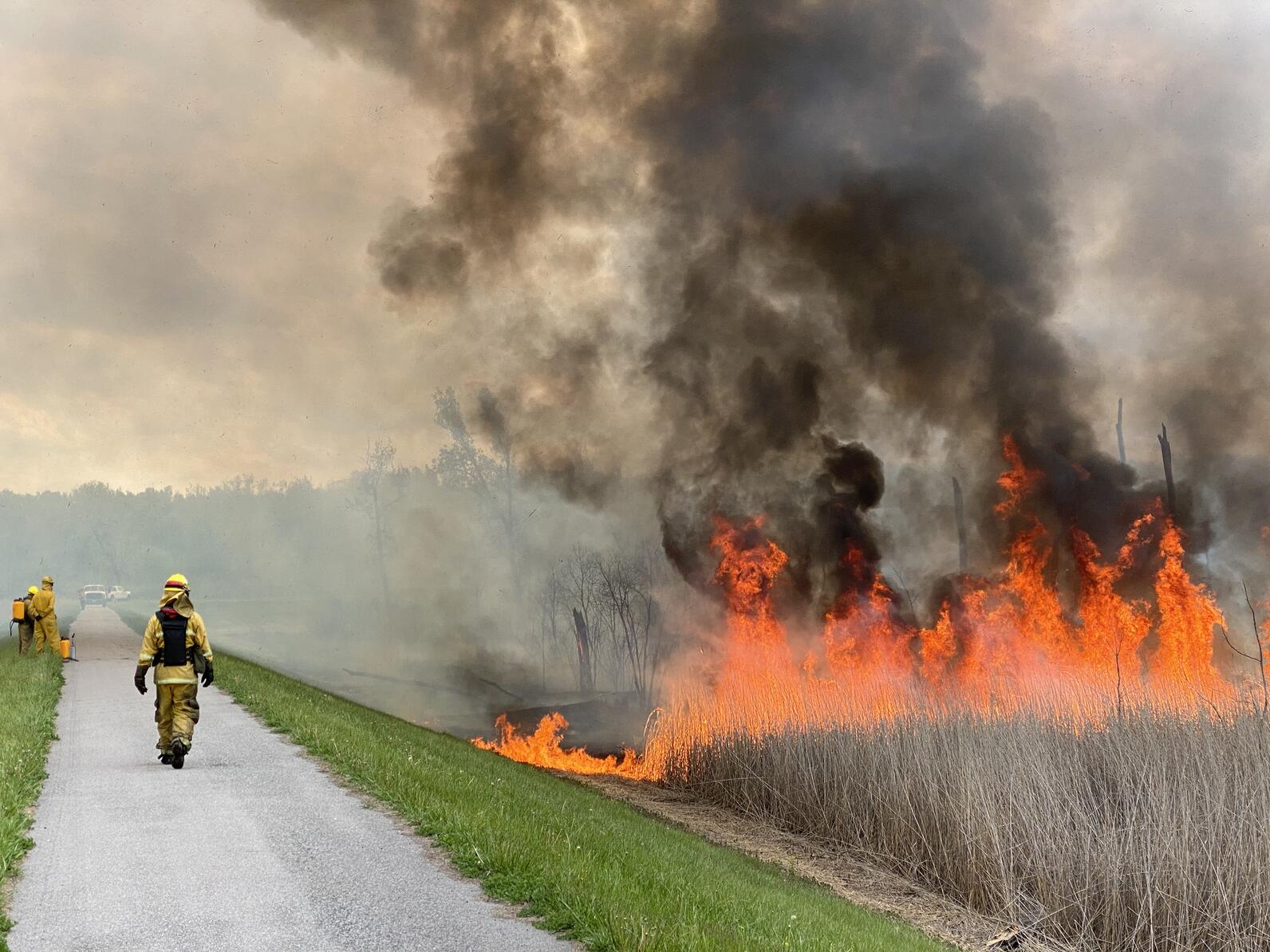(November 22, 2024) This past spring, Matt Kalwasinski, Vice President and Program Coordinator for Dunes-Calumet Audubon Society, was enjoying some early morning birding in Northwest Indiana when he made some exciting discoveries: two families of Sandhill Cranes -- one walking among the cattail of MLK South wetlands and one at Grant Street Marsh, two sites where Audubon Great Lakes is working with partners to restore marsh bird habitat. These observations are a sign that the Calumet region is once again becoming a haven for nesting Sandhill Cranes, vulnerable marsh birds and other wildlife.
Dunes-Calumet Audubon Society, a chapter of the National Audubon Society, works to increase awareness about the importance of these restoration sites by engaging birders in guided bird walks and programs alongside Audubon Great Lakes and partners.
Dunes-Calumet Audubon Society members are also strong advocates for the projects, sharing the need for restoration and critical wetlands protections to help preserve these areas for years to come with legislators and at public meetings.
Sandhill Cranes: An Indicator Species

Sandhill Cranes migrate through Indiana in great numbers each spring and fall. A passionate birder since 2010, Kalwasinski experienced another Sandhill Crane siting this year – but this time the birds numbered in the thousands. While leading a bird walk at Indiana Dunes National Park, Kalwasinski witnessed an unforgettable sight: nearly 10,000 Sandhill Cranes soaring overhead.
Right now, through December, birders across the state can witness this incredible migration of Sandhill Cranes as they travel south – don't forget to look up if you hear their prehistoric calls – you may miss out on the chance to see tens of thousands of Sandhill Cranes on the move!
Sandhill Cranes are a wonder to watch during migration as they travel gracefully in great numbers through Indiana each spring and fall. Sandhill Cranes aren’t just beautiful -- they’re also a crucial indicator species that reflect the condition of the environment. Sandhill Cranes rely on wetlands and prairie for nesting and migration. When they thrive, it’s a sign that wetland ecosystems are healthy and resilient.
Within the last few decades, Sandhill Cranes have greatly expanded their nesting range and numbers in the upper Midwest, a population that migrates southeastward toward Florida for the winter. Although they are common across much of North America, Sandhill Cranes depend on key stopover sites where they rest and refuel during migration.
In Northwest Indiana there are only a few areas where tens of thousands of migratory Sandhill Cranes will spend the night to rest and refuel: Jasper-Pulaski Fish and Wildlife Area, and wetlands and open fields in La Porte and Jasper Counties. Thousands of Sandhill Cranes can be seen at Jasper-Pulaski through early December, and La Porte and Jasper Counties have become winter homes for thousands of Sandhill Cranes through January. If these high-quality habitats are lost or degraded, these majestic Sandhill Cranes will no longer be able to rest and refuel before they continue their journey south, putting them at risk of starvation and exhaustion.
Sandhill Cranes are also a highly vulnerable species to climate change and are at risk of extinction across the Great Lakes region, according to Audubon’s Survival by Degrees Report, making them one of Audubon’s priority species.
Collaborative Restoration in the Calumet Region

The Calumet region, which includes Northwest Indiana, is a critical area for conservation. Once home to nearly 45,000 acres of marsh and wet prairie, this region suffered extensive habitat loss due to industrial development. Breeding marsh bird populations were decimated as wetlands were lost to factories, industry and urbanization.
Audubon scientists identified the Calumet region as one of the 12 Great Lakes coastal wetland areas most in need of conservation for vulnerable marsh birds. Audubon Great Lakes is working with partners to restore wetlands across the Calumet region, including at MLK South Wetlands and Grant St. Marsh in Gary, Indiana.
Partners include Lake County Parks and Recreation, The Nature Conservancy of Indiana, The Wetlands Initiative, Northern Indiana Public Service Company, Little Calumet River Basin Development Commission, Dunes-Calumet Audubon Society, Indiana Department of Natural Resources and others.
Over 8,000 acres have been restored to improve conditions and form “hemi-marsh" —wetlands -- a mix of open water and emergent vegetation that marsh birds need to thrive. To restore wetlands, the restoration primarily focused on removing invasive species through restoration techniques including prescribed burns. A water control structure was installed, enabling habitat managers to adjust the water level to curb invasive species and support native habitat conditions that marsh birds need.
Community engagement is central to this effort; Audubon Great Lakes, Dunes-Calumet Audubon Society and other partners have led workshops, outreach events and surveys to gather local insights, which are helping to shape the restoration projects.
Thanks to collaborative restoration efforts across the Calumet region, the Sandhill Crane population is stable and restored wetlands continue to provide essential nesting grounds for Sandhill Cranes and stopover sites for migratory birds. In newly restored Calumet wetlands we have also begun to see nesting marsh bird populations stabilize and, among several species, we are seeing increases in the number of breeding individuals.
Get Involved
- The threat of habitat loss remains, and ongoing advocacy and action are crucial to protecting these special places. Join the Audubon Great Lakes climate movement and sign-up to become an advocate to learn how you can get involved.
- Dunes-Calumet Audubon Society hosts events and volunteer opportunities throughout the year, including the upcoming Christmas Bird Count and Climate Watch, two winter community science programs coordinated by National Audubon Society where volunteers look and listen for winter birds. The Christmas Bird Count period is from December 14 – Jan 5. The winter Climate Watch Survey Period runs from January 15 – February 15.
- Dunes-Calumet Audubon Society also hosts year-round guided bird walks where Kalwasinski and other field trip leaders encourage birders to venture out to areas that are off the beaten path -- like MLK South wetlands -- and submit checklists of their bird observations to eBird, a global community science dataset that informs bird conservation. By encouraging birders to visit less-frequented areas and submit eBird checklists, Dunes-Calumet Audubon Society is helping to fill critical data gaps in eBird at some of our restoration sites, like MLK South. Visit the Dunes-Calumet Audubon Society website, Facebook page, or email them directly to learn more about how you can get involved in their bird walks, community science and stewardship initiatives.
Whether you volunteer, participate in citizen science, or simply share this story, your involvement makes a difference. Together, we can ensure these vibrant habitats remain safe for wildlife and a cherished resource for future generations. Let’s take inspiration from the Sandhill Cranes and continue this vital work of conservation and stewardship for a healthier, more resilient world.
-- Izabela Grobelna, Engagement Manager for Audubon Great Lakes, with contributions by Sandra Coleman, Intern for Audubon Great Lakes





